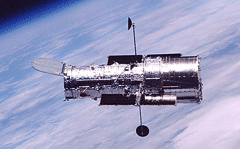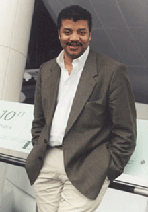Hubble Trouble
Air Date: Week of October 3, 2008

The Hubble Space Telescope has been in orbit for 18 years. (Courtesy of NASA)
From the delayed Hubble Space Telescope mission to the recent discovery of snow on Mars, astrophysicist Neil deGrasse Tyson, director of New York’s Hayden Planetarium, fills us in on what’s up in space.
Transcript
GELLERMAN: It's Living on Earth, I'm Bruce Gellerman.
The Hubble’s in trouble. For the past eighteen years the giant space telescope has been orbiting the earth, revealing images of deep space and distant time. But the aging observatory has problems. A shuttle mission to update equipment on the telescope was supposed to launch this week, but the flight has been delayed until sometime next year. It seems technicians discovered a faulty data link aboard the Hubble, making the shuttle trip useless till that problem’s fixed.
So far the Hubble project has cost upwards of ten billion. Have we gotten our money’s worth? Well, when things turn celestial, we turn to Neil DeGrasse Tyson. He’s director of the Hayden Planetarium in New York City - and he says, Hubble’s payback has been out of this world.
TYSON: I would say Hubble wears two hats. One of them is the “Look how cool the universe is” hat. And in that capacity, it produces these gorgeous color images that we all know and love. We’ve all downloaded and put on our screensavers on our computers. And so it brought the universe into our collective backyard. It’s kind of an ambassador to the cosmos. The other hat is simply its scientific discoveries, one of which was it gave us the first accurate estimate for the age of the universe – about 13.7 billion years.

A helix nebula recorded by the Hubble Space Telescope—often referred to as "the eye of God." (Courtesy of NASA)
GELLERMAN: Space Exploration Technology, a private company, just was able to launch the first private payload into orbit. Big deal, huh?
TYSON: Yeah - Yeah, actually, if you’re in the circle we called them Space Ex. That’s a whole new way of getting into orbit, new in the sense that one is not relying on government spacecraft or the economy of cost that is associated with government spending versus corporate. So the whole point of Space Ex is to try to reduce the cost of access to space.
GELLERMAN: But the cost of putting a pound in orbit has pretty much stayed the same these many years.
TYSON: Yeah it has. It varies depending on what is your technology to do it. The shuttle turned out to be vastly more expensive than anyone had hoped for. Because part of it is not simply what it costs to launch a vehicle. There’s a whole other aspect to the cost of launch, and that is what is the cost of the system that produces the launch vehicle itself. The factories, the employees - all the rest of that. And some of those are just simply fixed costs, and if you launch only once a year or twice a year those huge fixed costs get divided into only a couple of shuttles. And so it doesn’t work out yet until you start launching at a very regular rate.
GELLERMAN: So this per launch rate is sort of like Netflix – you know, the more you order –
[LAUGHING]
TYSON: Exactly. The more you do it the cheaper per viewing it is, per launch it is. That’s the exact model right there.
GELLERMAN: I wanted to ask you about my favorite spacecraft, the Phoenix Mars Lander.
TYSON: Oh yeah.
GELLERMAN: Just discovered that there’s snow on Mars. What does snow on Mars mean?
TYSON: Well, what I like about the snow is that it means the ice is not just locked somewhere, it’s not just buried in a permafrost which – we’re pretty sure that where most of the water that was once on Mars is now kept -“kept” sounds like aliens are keeping it there - where it’s now found. The fact that you have precipitation, tells you that there are cycles of water. And any time you have cycles, you have occasions to explore with different kinds of chemistry. And chemical explorations are just the kinds of things that can spawn life. You can get different kinds of molecules doing different things under different circumstances. And therein is the chemical experimentations that we’re pretty sure led to life here on earth.

Neil deGrasse Tyson, director of New York's Hayden Planetarium. (Courtesy of
Patrick Queen, reprinted with permission of Prometheus Books)
TYSON: My one question – and I’m not alone with this question, I don’t claim unique thinking here. I wanna know whether or not we are alone in the universe. And that takes more evidence than fuzzy photos of lights in the sky. If somebody’s out there, have ‘em come down here, land in Times Square, come out and shake everybody’s hand. There you go. That’s my evidence. That’s the evidence I’m looking for. One thing I really worry about is whether that’s happened already, but nobody noticed because in Times Square everyone looks really weird.
[LAUGHING]
TYSON: That’s one of my great concerns. But, you gotta wonder that. If they’re out there, what have they learned about the universe that we have yet to discover. How much smarter than we are they and what can they share with us? It could be that it’s possible to become so smart that you invent all kinds of clever ways to kill yourself and to kill others and that it’s a self-limiting process. There’s a limit to how smart a civilization can be because they’ll just kill themselves.
[LAUGHING]
TYSON: So, there’s all these ways of thinking. A lot of it is sort of anthropic because we know we’re capable of killing ourselves ten times over, so surely they would be able to do the same. I’ve got another worry. Here we are on earth. Other than plants, every other life form on earth has to kill something in order to survive. All food you’ve ever eaten except for salt was once alive. Right? Now, that’s in a way, kind of barbaric given the sources of energy freely available on the sun.

The Hubble Space Telescope has been in orbit for 18 years. (Courtesy of NASA)
GELLERMAN: When you look into space and you see the first star at night, do you make a wish?
TYSON: Ah, no. Because I know that the first star you see at night is usually a planet, and so I’m not fooled by that.
[LAUGHING]
TYSON: The planets are brighter than the stars.
GELLERMAN: Next thing the tooth fairy is going to be under attack by you.
TYSON: Ah, no. So most people who wish upon a star, are wishing upon planets and, see, that’s why their wishes aren’t coming true.
GELLERMAN: That’s great. You’re awesome, Dr. T. Thank you.
TYSON: No, the universe is awesome, I’m just your conduit to the awesomeness.
[LAUGHING]
GELLERMAN: Neil DeGrasse Tyson, director of the Hayden Planetarium in New York City.
Links
Living on Earth wants to hear from you!
Living on Earth
62 Calef Highway, Suite 212
Lee, NH 03861
Telephone: 617-287-4121
E-mail: comments@loe.org
Newsletter [Click here]
Donate to Living on Earth!
Living on Earth is an independent media program and relies entirely on contributions from listeners and institutions supporting public service. Please donate now to preserve an independent environmental voice.
NewsletterLiving on Earth offers a weekly delivery of the show's rundown to your mailbox. Sign up for our newsletter today!
 Sailors For The Sea: Be the change you want to sea.
Sailors For The Sea: Be the change you want to sea.
 The Grantham Foundation for the Protection of the Environment: Committed to protecting and improving the health of the global environment.
The Grantham Foundation for the Protection of the Environment: Committed to protecting and improving the health of the global environment.
 Contribute to Living on Earth and receive, as our gift to you, an archival print of one of Mark Seth Lender's extraordinary wildlife photographs. Follow the link to see Mark's current collection of photographs.
Contribute to Living on Earth and receive, as our gift to you, an archival print of one of Mark Seth Lender's extraordinary wildlife photographs. Follow the link to see Mark's current collection of photographs.
 Buy a signed copy of Mark Seth Lender's book Smeagull the Seagull & support Living on Earth
Buy a signed copy of Mark Seth Lender's book Smeagull the Seagull & support Living on Earth

